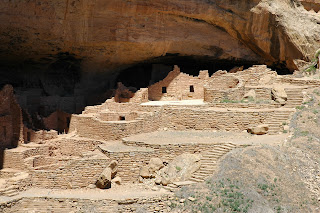Here is one of the smaller "cities" now built under the ledges. This provided shelter from the North Wind and some form of defense. They continued to farm on top of the mesa, but stored the corn in rooms in the complex.
A little more detail. This building was 4 stories tall when the complex was inhabited.
They seemed to be almost everywhere...if you looked closely enough.
Here is a telephoto shot of the cliff above.
To make the ruins accessible to the public, the CCC carved these very narrow pathways and inserted ladders to climb up and down to the sites. John is turned sideways and note the width of the path right behind him. Tight squeeze for some people on the hike.
Ladders...and more ladders...
Longer view of the last place we saw. One of the issues was always availability of water. This complex was especially well placed because there were seeping springs in the back of the overhang (next picture). They made indentions in the floors next to the seepage rocks, so they could capture the water for personal use. Still not enough to make the mortar for building. They made the mortar during the wet season (July and August). There is no lake, stream or river in any of these three mesas. Talk about water conservation.
This is the back of the cave/overhang that indicated there was a water source. Of course, they would have dragged away all this greenery and caught the seepage in containers or the indentations hollowed out in the floor.
How would you like to make this climb several times a day carrying water jugs on your head, bundles of stick for the fires or even a small baby? The life expectancy was around 30 for women and 32 for men. That's an average from a range from several numbers quoted by several different ranger talks. They ground their corn with a smooth rock against sandstone indentations. Needless to say, along with the ground corn, they also got a lot of sand. This caused their teeth to grind down, exposing the nerves and causing abscessed teeth and increasing the incidence of infection. There was also a high incidence of arthritis from always sitting or squatting on the ground to work and eat.
These small (high in the air so they are actually about 6 feet tall) openings were to the corn/grain storage areas. It was a precious commodity and very strictly guarded. When the complex was intact, the roofs would have been that high on the wall and people would have walked across the roof to put the grain in or out. Now, these are about 50 feet up the wall.
For perspective, if you were sitting inside the complex, this is your view looking out and down the valley. The shadow is the end of the ledge before falling away below.
Now ... after the history fun, I have to share something. As most of you know, this blog was my/our first and it's been a lot of "learn by doing". A few days ago, I realized that there was a place to see the comments from all of you. So sorry I never even acknowledged them!! But thanks for your responses! I'll do better next time. :-)
One last note. We are staying at the Far View Lodge in the Mesa Verde National Park. It's a tiny but adequate room, typical National Park, well worn construction but the location is incredible. Our room has a small balcony and large windows that look over the mesa. Last night, I opened the drapes completely and was nice and warm in my bed, watching the stars as everything got dark in the park. Just as I thought it couldn't get any better, I saw a shooting star! How cool is that???? Have a good night everyone.












One of my favorite places - Mesa Verde! We visited it 25 years ago....Jill
ReplyDeleteYou should definitely come back. Full of magic, awe and wonder! One more day and then we're on to Ouray. Marilyn
DeleteDefinitely on my list of places to visit!
ReplyDelete